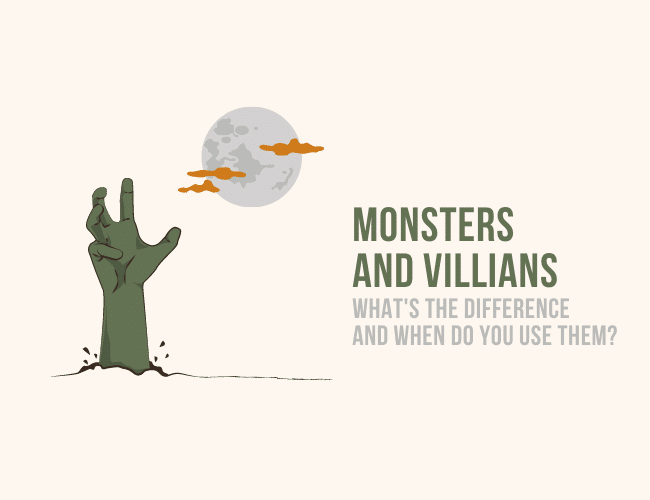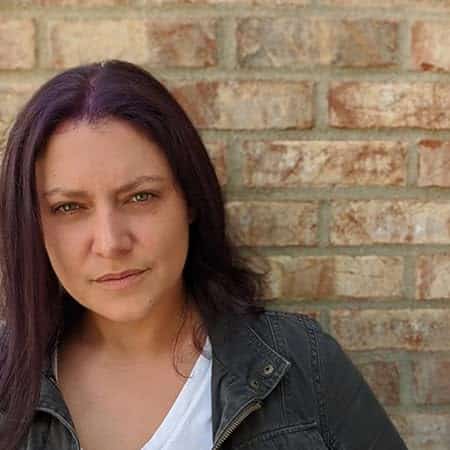Both villains and monsters are considered antagonists, but there are differences between the two. You'll want to choose which version of antagonist you're using based on the purpose and tone of your story.

The Main Difference Between Villains and Monsters
You probably think this is an easy one. “Well, monsters are . . . monstrous. Villains aren't.” This isn't quite correct. The concentration in this statement is on looks. You're probably thinking about size, shape, and “otherness.” But there can be “monstrous-looking” villains (Two-Face, for instance) and monsters that are humanoid (Sil, discussed later).
The main difference between villains and monsters is pretty simple: it all comes down to motivation.
You probably consider motivation with your protagonist, but do you do it with your antagonist? You should. Otherwise, your antagonist is flat and uninteresting. Not to mention probably not really scary (if scary's what you're going for).
No matter what character you're writing (including B characters!), you should always, always understand their motivation.
The Monster vs. Villain Spectrum
Consider a spectrum. On the left side is a pure monster. The right side is a pure villain. There's a sliding scale in between.
I said this all comes down to motivation, right? So your pure monster on the left has base motivations, like breeding, feeding, and surviving. There's no reasoning with a monster, as they have no sympathy for you. They are pure id.
Examples: Jaws, The Blob, Alien. All of these monsters have the desire to eat and/or breed. They are a machine in that respect.
(A machine can also be an antagonist, by the way, though whether it's a monster or a villain depends on how it came to be. A sentient AI, for example, would be more villain. A rogue robot would be more monster.)
Note: Just because monsters have simplistic motivation doesn't mean you don't have to put work into their development. Check out this post on how to create great monsters.
Now let's look at the right side of the spectrum and consider the motivation of the pure villain. There is no right answer to the motivation of a villain. A villain is (typically) humanoid, and as such has a wealth of backstory, personality traits, and goals/desires. A villain is more difficult to develop because of this. You need to spend just as much time considering them as you do your protagonist.
Examples: Hannibal Lecter, Voldemort, Nurse Ratched, Lex Luthor, the Joker, Darth Vader . . . I think you get the point. Villains are rounded characters with often relatable and/or sympathetic characteristics. They're capable of interacting without violence and can be thoughtful instead of rash. They're complicated.
The Spectrum's Middle
So you've got your pure monster to the left and your pure villain to the right. What's in the middle?
Let's consider Dracula. He's humanoid, but he's not human. His motivations include feeding, but that's not the only thing he wants. He's a complicated mix of monster and villain, so he goes in the middle. I would place him to the right of the middle, as his motivations (and looks) are more humanoid than monstrous.
Now let's look at Pennywise, the clown from Stephen King's It. He's mostly inhuman in appearance (especially in the book), compulsively generates fear, and feeding is definitely up there on his priority list. Those are checkmarks for the monster column.
But he also loathes the band of friends, is able to communicate without being violent, and revenge plays a major part in his motivation to terrorize the main characters. Those are villainous qualities. Pennywise goes in the middle of the spectrum as a nice mix of villain and monster.
One more example of someone in the middle: Sil from the movie Species. Sil is humanoid (she's alien DNA spliced with human DNA and considered very beautiful), yet her motivation is to survive so she can breed.
While Sil does have a sympathetic background (she was made in a lab and her creators tried to kill her as a child), she's not a sympathetic character in the slightest. She's single-minded and often unnecessarily violent.
Sil belongs in the middle, quite close to the left/monster side of the spectrum, despite being humanoid in appearance most of the time. See, not every monster is monstrous-looking.
When to Use a Monster
Since monsters have rather simplistic motivations, they add a threat to a story and to your main characters. There's a lot of fear surrounding monsters, so they are much more common in horror stories than anywhere else. Not that villains can't inspire fear, but the nature of a monster makes fear a more natural state.
Monsters are, after all, “other” and more unsympathetic. It's easier for the protagonist to kill a monster.
A story using a monster as an antagonist has plenty of room for character development for your protagonist. Use a monster when you want to put a lot of focus on your main character and their struggles.
There's very little in the way of explaining a monster's backstory or worrying about his motivations (because he's trying to eat you). The focus is on survival for the main characters and their character arcs in the process.
The most common character arc here is the main character going from “weak” to “strong” in order to defeat the monster.
When to Use a Villain
Villains bring tension to your story. Like monsters, they can also bring fear, but since their motivations are more cerebral and they tend to look human, pure fear is less common.
The character arc of your protagonist is directly affected by the villain, as it is by monsters, but in a more nuanced way. Protagonists can often be tempted by, or sympathetic toward, villains in a way they can't be with monsters. Character arcs for your main characters when up against a villain are also more interesting.
Rather than focusing more on survival for your main characters, you can look at morality, wit, dedication to ideals, anything really.
What's the Purpose of Your Story?
The purpose is where you should start with every story. In other words, what's your story's motivation?
Are you going for a fear fest? Are you wanting to point out problems with society? Are you wanting your main character to struggle with their own morality? Do you want to develop a really kickass creature to let loose on a town?
What if it's a little bit of all of the above? Then develop a monstrous villain or a villainous monster!
Your antagonist in every situation is there to serve your story. Think about how you want them to serve your story, and the best way to have them do so, before you start writing and you'll be well on your way to developing an awesome story!
Think about Frankenstein's monster. Where do you think he falls on the Monster vs. Villain Spectrum? Let me know in the comments!
PRACTICE
Today you're going to develop an antagonist. First, choose whether you want to develop a monster or a villain. (If you're going for monster, definitely check out this post on building great monsters. If you're going for a villain, you'll need backstory, personality traits, etc.)
Then, set a timer for fifteen minutes. Develop your monster or villain. In either case, DON'T FORGET THE MOTIVATION!
When you’re done, share your writing in the comments. Don’t forget to comment on your fellow writers’ work!
Sarah Gribble is the author of dozens of short stories that explore uncomfortable situations, basic fears, and the general awe and fascination of the unknown. She just released Surviving Death, her first novel, and is currently working on her next book.
Follow her on Instagram or join her email list for free scares.




0 Comments